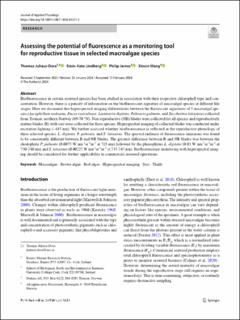| dc.contributor.author | Juhasz-Dora, Thomas | |
| dc.contributor.author | Lindberg, Stein-Kato | |
| dc.contributor.author | James, Philip | |
| dc.contributor.author | Wang, Xinxin | |
| dc.date.accessioned | 2024-04-05T12:54:20Z | |
| dc.date.available | 2024-04-05T12:54:20Z | |
| dc.date.created | 2024-04-04T12:15:47Z | |
| dc.date.issued | 2024 | |
| dc.identifier.citation | Journal of Applied Phycology. 2024, . | |
| dc.identifier.issn | 0921-8971 | |
| dc.identifier.uri | https://hdl.handle.net/11250/3125122 | |
| dc.description.abstract | Biofluorescence in certain seaweed species has been studied in association with their respective chlorophyll type and concentration. However, there is a paucity of information on the biofluorescent signature of macroalgal species at different life stages. Here we document that hyperspectral imaging differentiates between the fluorescent signatures of 5 macroalgal species (Ascophyllum nodosum, Fucus vesiculosus, Laminaria digitata, Palmaria palmata, and Saccharina latissima) collected from Tromsø, northern Norway (69-70 °N). Non-reproductive (NR) blades were collected for all species and reproductively mature blades (R) with sori were collected for three species. Hyperspectral imaging of collected blades was conducted under excitation lighting (~445 nm). We further assessed whether biofluorescence is reflected in the reproductive phenology of three selected species, L. digitata, P. palmata, and S. latissima. The spectral radiance of fluorescence emissions was found to be consistently different between R and NR blades. The greatest difference between R and NR blades was between the rhodophyte P. palmata (0.0075 W nm-1sr-1m-2 at 725 nm) followed by the phaeophytes L. digitata (0.03 W nm-1sr-1m-2 at 730-740 nm) and S. latissima (0.00225 W nm-1sr-1m-2 at 735-745 nm). Biofluorescence monitoring with hyperspectral imaging should be considered for further applicability in commercial seaweed operations. | |
| dc.language.iso | eng | |
| dc.title | Assessing the potential of fluorescence as a monitoring tool for reproductive tissue in selected macroalgae species | |
| dc.title.alternative | Assessing the potential of fluorescence as a monitoring tool for reproductive tissue in selected macroalgae species | |
| dc.type | Peer reviewed | |
| dc.type | Journal article | |
| dc.description.version | publishedVersion | |
| dc.source.pagenumber | 0 | |
| dc.source.journal | Journal of Applied Phycology | |
| dc.identifier.doi | 10.1007/s10811-024-03211-3 | |
| dc.identifier.cristin | 2258860 | |
| cristin.ispublished | true | |
| cristin.fulltext | original | |
| cristin.qualitycode | 1 | |
